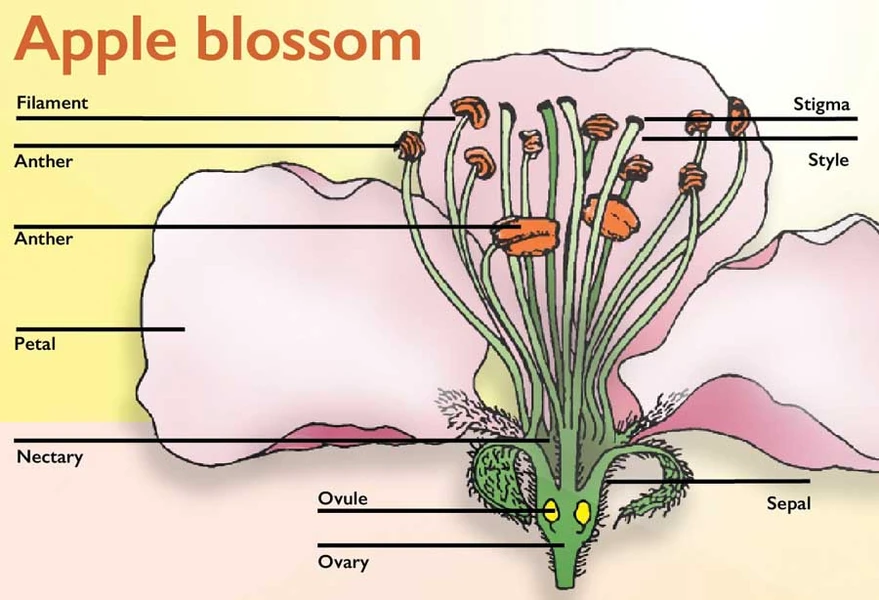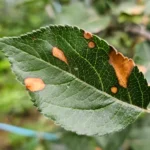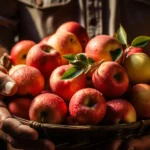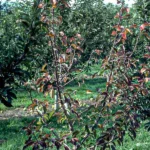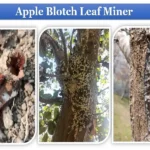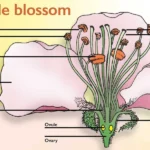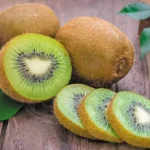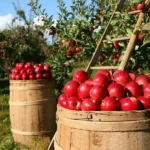Pollination is the process by which pollen is transferred from the male reproductive organs of a plant to the female reproductive organs. This results in fertilization and the production of seed. In the case of apple trees, pollination is essential for the development of fruit. Check important information about Kiwi Cultivation in Kashmir
Apple trees are generally self-incompatible, meaning that they cannot pollinate themselves and require another apple tree for pollination. The recommended pollinizers for Red delicious are Golden Delicious, GD Clone-B, GD Rainders, Red Gold, Granny Smith, Gala, Mollies Delicious etc. Support us by subscribing our YouTube Channel
Types of Pollination
There are two main types of pollination: self-pollination and cross-pollination.
Self Pollination
Self-pollination occurs when the pollen from the anthers (male reproductive organs) of a flower fertilizes the pistil (female reproductive organ) of the same flower or of another flower on the same plant. This type of pollination is common in plants that have evolved to be self-fertile, as it increases the likelihood of successful fertilization and the production of seeds. Self-pollination also helps to maintain the genetic purity of the plant population, as it allows for genetic recombination within the plant.
Cross Pollination
Cross-pollination, on the other hand, occurs when the pollen from one plant fertilizes the pistil of a different plant. This type of pollination is common in plants that are not self-fertile and require assistance from pollinators to transfer the pollen from one plant to another. Cross-pollination is important for maintaining the genetic diversity of plant populations, as it allows for the exchange of genetic material between different individuals.
Pollinators
Apple trees can be pollinated by a variety of insects, including bees, wasps, and moths. Honeybees are the most commonly used insect for apple pollination. They are highly efficient pollinators and can be easily managed by beekeepers.
When an apple tree is in bloom, the bee will collect nectar from the flowers and transfer pollen from the anthers to the pistils. This process is known as cross-pollination and results in the development of fruit.
Factors Affecting Pollination
There are many factors that can affect the pollination of apple trees, including weather conditions, the presence of other plants in the area, and the health of the tree itself. In order to ensure successful pollination, apple growers must pay close attention to these factors and take appropriate measures to ensure optimal conditions for pollination.
One of the most important things that apple growers can do to promote pollination is to provide a suitable habitat for pollinators. This includes planting a variety of plants that bloom at different times of the year, providing nesting sites for bees and other insects, and reducing the use of pesticides.
Another important factor to consider is the timing of the bloom. Apple trees typically bloom in the spring, but the exact timing can vary depending on the variety and the climate. In order to ensure successful pollination, apple growers must pay close attention to the timing of the bloom and take steps to synchronize the blooming periods of different varieties.
Finally, apple growers must also be mindful of the health of the tree itself. This includes regular pruning and maintenance to ensure that the tree is in optimal condition for pollination.
Fertilization
One of the challenges of cross-pollination is ensuring that the pollen from one plant reaches the pistil of another plant at the same time that it is receptive to fertilization. This is particularly important for crops that have a short period of time during which they are receptive to fertilization, as a failure to transfer the pollen during this time can result in a failed crop.
In conclusion, pollination is an essential process for the production of apples. By understanding the role of pollinators, the factors that affect pollination, and the steps that can be taken to promote pollination, apple growers can ensure a successful harvest.
Author
Dr. Syed Samiullah
Ph.D Fruit Science

